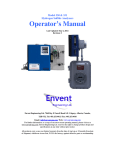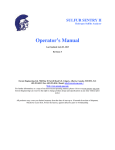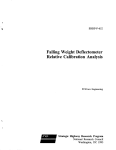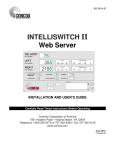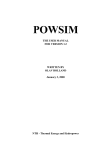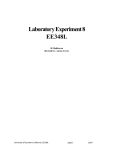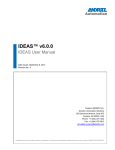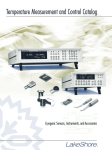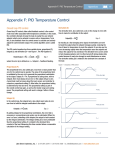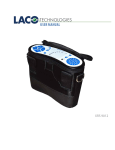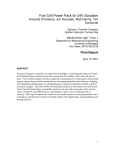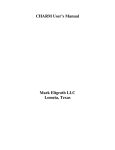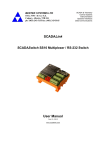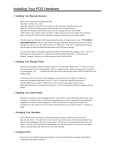Download User Manual - Envent Engineering
Transcript
Envent Engineering Ltd. 330SDS & 331SDS Operator’s Manual
22/May/15
Last Updated:
TABLE OF CONTENTS
A.
Figures and Tables.....................................................................................................2
A.1.
A.2.
B.
Introduction................................................................................................................3
B.1.
B.2.
C.
Warnings and Cautions.................................................................................................................4
Technical Specifications...............................................................................................................5
Principle of Operation...............................................................................................6
C.1.
C.2.
D.
Figures...........................................................................................................................................2
Tables............................................................................................................................................2
Eductor Vent Assembly................................................................................................................8
Operator Interface.........................................................................................................................9
Installation and Start-up.........................................................................................10
D.1.
Sample Point Selection................................................................................................................10
D.2.
Sample Volume and Flow Rate...................................................................................................10
D.2.1. Sample Lag Time vs. Tubing Size.........................................................................................10
D.3.
Sample Conditioning...................................................................................................................11
D.4.
Installation Procedure..................................................................................................................12
E.
Customer Connections............................................................................................13
E.1.
Relay Outputs and Solenoid Driver............................................................................................14
E.2.
Analog Outputs...........................................................................................................................15
E.2.1.
Alarm Set Points...................................................................................................................16
F.
Calibration................................................................................................................17
F.1.
Calibration & Alarms..................................................................................................................17
F.2.
Calibration Procedure..................................................................................................................17
F.2.1.
Re-Zero Sensor Procedure....................................................................................................18
F.2.2.
Tape Change Procedure.......................................................................................................19
G. Maintenance & Troubleshooting............................................................................20
G.1.
G.2.
G.3.
Monthly Checkup........................................................................................................................20
Troubleshooting..........................................................................................................................20
Sample Conditioning System Cleaning Procedure.....................................................................22
APPENDICES..................................................................................................................23
Modbus Registry........................................................................................................................................23
Recommended Spare Parts List.................................................................................................................24
H2S Concentration Conversion Factors....................................................................................................24
Sub Assemblies..........................................................................................................................................25
Computer Software....................................................................................................................................26
Standard System Drawing.........................................................................................................................27
Recommended Venting.............................................................................................................................28
Calibration Gas Humidifier.......................................................................................................................30
Controller Board Schematic......................................................................................................................31
Chico A Sealing Compound......................................................................................................................32
Optional Low Pressure Switch..................................................................................................................33
2
Envent Engineering Ltd. 330SDS & 331SDS Operator’s Manual
22/May/15
Last Updated:
Figures and Tables
A.1.
Figures
Figure 1: 330S & 331S Analyzer principle of operation diagram....................................................................6
Figure 2: Sample chamber and parts................................................................................................................7
Figure 3: Eductor block information diagram..................................................................................................8
Figure 4: 330-standard operator interface (similar to 331)..............................................................................9
Figure 5: 331&330 Flow Diagram.................................................................................................................11
Figure 6: Controller Board Layout & Power Input........................................................................................13
Figure 7: Relay outputs and solenoid drivers.................................................................................................14
Figure 8: (4-20 mA) Output Wiring Options.................................................................................................15
Figure 9: Powered 4-20 mA option................................................................................................................16
Figure 10: 331 Tape change procedure (similar to 330)................................................................................19
Figure 11: 330 Motor box assembly (exploded)............................................................................................25
Figure 12: Sensor chamber assembly (exploded)...........................................................................................25
Figure 13: 331 RS-232 Communication connection......................................................................................26
Figure 14: 330 DIN Receptable communication connection.........................................................................26
Figure 15: 331 Standard system drawing.......................................................................................................27
Figure 16: 330 Standard system drawing.......................................................................................................27
Figure 17: 330 Recommended venting...........................................................................................................28
Figure 18: 331 Recommended venting...........................................................................................................29
Figure 19: Calibration gas humidifier............................................................................................................30
Figure 20: Controller board schematic...........................................................................................................31
A.2.
Tables
Table 1: Technical Specifications....................................................................................................................5
Table 2: *Range & Aperture Information........................................................................................................7
Table 3: Analyzer display-button functions.....................................................................................................9
Table 4: Sample Lag Time vs. Tubing Size...................................................................................................10
Table 5: Customer connection summary (see Figure above).........................................................................13
Table 6: Troubleshooting recommendations..................................................................................................20
Table 7: Default Modbus Registry list...........................................................................................................23
Table 8: Recommended spare parts list for 2 years........................................................................................24
Table 9: H2S Concentration conversion factors.............................................................................................24
3
Envent Engineering Ltd. 330SDS & 331SDS Operator’s Manual
22/May/15
B.
Last Updated:
Introduction
The Envent Engineering Ltd. model 330SDS & 331SDS hydrogen sulfide analyzers can
be configured via software and hardware to measure a wide range of hydrogen sulfide
concentrations in gases as well as in liquids.
With the addition of a hydrogen reaction furnace, the analyzer is also capable of total
sulfur measurement. This manual describes the operation of the hydrogen sulfide
analyzer. Additional sections will describe the operation of any optional equipment.
This manual contains a comprehensive overview of Envent Engineering’s 330SDS &
331SDS H2S analyzer and step-by-step instructions on:
•
•
•
•
Installation and Startup
Operation
Maintenance
Troubleshooting
This manual should be read and referenced by the person who will install, operate, or
have contact with the 330SDS and/or 331SDS. Take time to familiarize yourself with the
content of this Operator’s Manual, reading each section carefully so you can quickly and
easily install and operate the analyzer.
The manual includes images, tables, and charts that provide a visual understanding of the
analyzer and its functions. Take note of all the caution symbols and notes, as they will
alert you of potential hazards and important information.
4
Envent Engineering Ltd. 330SDS & 331SDS Operator’s Manual
22/May/15
B.1.
Last Updated:
Warnings and Cautions
CAUTION: The analyzer should be mounted in an area in which it is not exposed to vibration;
and excessive pressure, temperature, and environmental variations.
CAUTION: Ensure that the analyzer received is suitable for the installation location electrical
classification of the installation site.
• The 330SDS is designed for Class I Division 1 Groups B, C,D
• The 331SDS is designed for Class I Division 2 Groups A,B,C&D
CAUTION: Analyzer may utilize an optional CCS, Model 646 Series pressure switch located on the
side of the electrical enclosure:
• Dual Seal, MWP 500PSI
•
Annunciation is Visible Leakage from the pressure adjustment cover (Flow from this cover can
indicate the possibility that a failed primary seal condition could exist in the pressure switch.)
CAUTION: 330SDS Seals Not Poured. Pour seals before energizing the circuit (see APPENDIX)
CAUTION: Dis-assembly of the pressure regulator and solenoids in the field is not advised. Consult
the factory if the regulator or solenoid appears contaminated.
CAUTION: Before resuming line pressure be sure that all port connections, sample sweep, and
sample conditioning system are securely installed.
CAUTION: All connections must be LEAKTIGHT to insure the effectiveness of the analyzer as well
as SAFETY. The user, through his own analysis and testing, is solely responsible for the product
selection and ensuring all responsibility, safety and warning requirements of the application are met.
If the equipment is used in a manner not specified by Envent Engineering Ltd., the protection
provided by the equipment may be impaired.
CAUTION: Do not use solvents, brake cleaner, soaps or detergents.
CAUTION: Turn off power before servicing.
disconnecting supply power.
Ensure breakers are off before connecting or
CAUTION: This unit may require a disconnect device rated 24 VDC and 5A max, must be protected
by a circuit breaker rated 24 VDC and 5A max, and is to be installed in accordance with
local electrical codes.
CAUTION: This unit may require a disconnect device rated 240 VAC and 5A max, must be
protected by a circuit breaker rated 240 VAC and 5A max, and is to be installed in accordance with
local electrical codes.
CAUTION: The eductor is required with model 331SDS in order to maintain electrical safety and
certification in Division 2 Areas
CAUTION: The glass window on the model 330SDS must remain installed in order to ensure area
classification is maintained
5
Envent Engineering Ltd. 330SDS & 331SDS Operator’s Manual
22/May/15
B.2.
Last Updated:
Technical Specifications
Table 1: Technical Specifications
Specifications
ASTM D4084 - 07: Standard Test Method for Analysis of Hydrogen
Sulfide in Gaseous Fuels (Lead Acetate Reaction Rate Method)
0-50 °C (standard) consult factory for other requirements, 0 to 90%
humidity (non-condensing)
12-24 VDC @ less than 3W
Or, 100-240 VAC 50/60 Hz, 5W,
(300W when total sulfur option is included)
330SDS Class I, Division 1 Groups B,C&D
Electrical
Certification 331SDS Class I, Division 2 Groups A,B,C&D
Certified to CSA standards File# MC 235646
Output Ranges Standard ranges are between 10-100 ppb and 0-100 ppm
Response time 20 seconds to 90% of step change
1.5% of reading on channel 1, 2.0% of reading on channel 2
Accuracy
Multi-character LCD with back lighting, menu is scrolled by internal
Display
button or magnetic wand (330SDS)
Two 4-20mA outputs (loop power required), optional 4-20mA powered
Outputs
output boards are available
Serial (1) RS-232 Modbus protocol
(2) RS-485 Modbus protocol
Two additional serial ports plus Ethernet as an option
4 SPDT relays (120 VAC 5A maximum)
4 solid state solenoid drivers
Optional Equipment
Total sulfur reaction furnace converts all sulfur compounds to hydrogen
Total Sulfur
sulfide which allows the analyzer to measure total sulfur
Option
Allows user to initiate a calibration based on time of day or manually
Auto
Calibration
Switches between multiple sample streams or between hydrogen sulfide
Stream
and total sulfur measurement
Switching
A permeable membrane dilution system allows the analyzer to measure
Dilution
ranges above 100 ppm
Liquid sample conditioning system to measure hydrogen sulfide in
Liquid
sampling
liquids
Measurement
method
Ambient
Temperature
Power
6
Envent Engineering Ltd. 330SDS & 331SDS Operator’s Manual
22/May/15
C.
Last Updated:
Principle of Operation
Envent Engineering Ltd. models 330SDS & 331SDS uses ASTM D4084 - 07: Standard
Test Method for Analysis of Hydrogen Sulfide in Gaseous Fuels (Lead Acetate Reaction
Rate Method). This method uses lead acetate impregnated paper, referred to by Envent
Engineering Ltd. as ‘H2S sensing tape”.
The H2S sensing tape reacts when in contact with hydrogen sulfide by the relationship
shown below. This reaction is visibly evident by a brown stain directly on the H2S
sensing tape. Considering this reaction, the electronics built into the Models 330SDS &
331SDS have been programmed to measure the rate of darkening over time which, in
turn, gives the hydrogen sulfide concentration.
2O
H 2 S + Pb(CH 3 COO ) 2 H
→ PbS + 2CH 3 COOH
Figure 1: 330SDS & 331SDS Analyzer principle of operation diagram
The figure above shows a flow regulated, pressure regulated and filtered process sample
gas passing through a membrane humidifier and into the sample chamber. (See the
following figure) A window in the sample chamber allows the gas to come in contact
with the sensing tape creating the brown stain. The SDS series uniquely measures rate of
change on both sides of the sensing tape. Allowing for simultaneous readings of two
samples.
7
Envent Engineering Ltd. 330SDS & 331SDS Operator’s Manual
22/May/15
Last Updated:
Gas Flow
Sample Inlet
Window
From humidifier
Aperture Strip*
Sensor block
clips
Trigger Slide
Sensor Block
+
Sensor Board
Sample Outlet
To Eductor
Figure 2: Sample chamber and parts
For concentration applications over 10 ppm there may be a restricting aperture behind the
window. Various sizes of apertures match different measurement ranges. See the table
below.
Table 2: *Range & Aperture Information
Aperture
Size
Range
100 ppb – 10 ppm
10 ppm – 20 ppm
20 ppm – 50 ppm
50 ppm – 100 ppm
More than 100 ppm
PN
None
NA
1/16”
330103
1/32”
330102
1/64”
330101
Consult Factory
8
Envent Engineering Ltd. 330SDS & 331SDS Operator’s Manual
22/May/15
1/4
1/4
1/8
1/8
1/8
D.3.
20
20
20
20
20
0.181
0.181
0.081
0.081
0.081
0.459
0.459
0.205
0.205
0.205
5
5
5
5
5
2359
2359
2359
2359
2359
Last Updated:
200
50
800
200
50
2.92
0.73
2.34
0.59
0.15
175
44
140
35
9
Sample Conditioning
The function of the optional sample conditioning system is to regulate and filter
particulates or free liquids from the sample. Consideration must be taken of upset
conditions as well as normal conditions when designing the sample conditioning system.
The figure below shows the typical sample conditioning system used for the 330SDS &
331SDS.
Sample conditioning systems are available that provide sample dilution, multiple stream
switching, auto-calibration, liquid measurement capability, and/or total sulfur
measurement.
Figure 5: 331SDS & 330SDS Flow Diagram
The standard, coalescing & regulated sample conditioning system consists of a 5000 psig
inlet filter and a 3000 psig inlet regulator. A three-way valve allows the user to switch
from sample gas to calibration gas. The sample sweep valve on the filter is left slightly
open to drain any liquids that may collect and to provide a sample sweep to reduce lag
time in the sample piping. There are labels on the sample system to indicate which sensor
is monitoring which sample of gas. The “1” label indicates the Primary sensor. The “2”
indicates the Secondary sensor.
12
Envent Engineering Ltd. 330SDS & 331SDS Operator’s Manual
22/May/15
E.1.
Last Updated:
Relay Outputs and Solenoid Driver
Four relays are provided as status outputs, to drive external relays or solenoids. Envent
recommends use of the solenoid drivers for external loads. DO NOT supply external
power to solenoid drivers. The four solenoid drivers provided to directly drive solenoids
for shutdown, auto-calibration or stream switching
.
Figure 7: Relay outputs and solenoid drivers
15
Envent Engineering Ltd. 330SDS & 331SDS Operator’s Manual
22/May/15
Last Updated:
E.2.
Analog Outputs Two isolated analog outputs are
provided. Both analog outputs are normally set to the full
scale range of the analyzer. Loop power (10 to 32 volts)
sourced from the end device (PLC) is required for the analog
outputs. If it is not possible to provide loop power, optional
powered AO boards are available.
16
Envent Engineering Ltd. 330SDS & 331SDS Operator’s Manual
22/May/15
Last Updated:
Figure 8: (4-20 mA) Output Wiring Options Alarm Set Points
Note: Optional 4 wire 4-20 ma option. The Model 330SDS & 331SDS comes standard
with 2 wire 4-20 ma output. An optional 4 wired powered 4-20 ma output is sometimes
included. It is a small board located just below the analog output terminal on the main
processor board.
Figure 9: Powered 4-20 mA option
17
Envent Engineering Ltd. 330SDS & 331SDS Operator’s Manual
22/May/15
F.
Last Updated:
Calibration
F.1.
Calibration & Alarms
Analyzer configuration and calibration was set at the factory. The factory gain and alarm
settings can be found in the factory calibration sheet, found at the end of this manual.
Analyzer settings can be read and adjusted using the operator interface.
F.2.
Calibration Procedure
Ensure a suitable calibration gas and a clean stainless steel regulator with the correct
CGA fitting is available. Check that the regulator is rated for calibration cylinder
pressure.
• The recommended calibration gas is hydrogen sulfide in a balance of
nitrogen certified and analyzed.
• Calibration gas concentration should be approximately 2/3 of the full scale
range of the analyzer or at the alarm point of the facility to be monitored
• Check the expiry date on the calibration gas bottle before using
• The recommended calibration gas supplier is AirGas
Note that the following instructions apply to analyzers with standard sample
systems; however, the basic principles still apply.
Step 1. Press the bypass button and verify that the “Bypass” LED illuminates
Step 2. Turn off calibration gas flow using the 3-way “Calibration In” valve
• Note that there should always be suction in the eductor (sample vent)
Step 3. Ensure there is enough H2S sensing tape (See E.2.2 if tape requires changing)
Step 4. Ensure there is enough 5% acetic acid, if the analyzer has a humidifier
Step 5. Push the “Menu/Set” button until “Mtr Run” is displayed
Step 6. Push the right arrow [ → ] to move the H2S sensing tape forward
• Ensure there is white tape at the sensor block window
Step 7. Press the “Menu/Set” button until the mV reading is displayed (“### mV”)
Step 8. If the mV reading is 1000 ± 100 mV, proceed to the next step, otherwise:
a. Ensure there is no brown stain on the sensing tape at the sensor block
window
b. Ensure the sample chamber is clean
c. Re-zero the sensor block (See section E.2.1 {Start at Step 4})
d. Re-check that the mV reading is 1000 ± 100 mV
Step 9. Connect calibration gas bottle to the “Calibration In” valve
a. If the analyzer does NOT use a humidifier, See Appendix: Calibration Gas
Humidifier for further instructions
Step 10.
Set the calibration gas pressure to 15 psig and the flowmeter to 2.0
Step 11.
Allow the analyzer reading to stabilize (10 to 15 minutes)
Step 12.
Press the “Menu/Set” button until the gain setting is displayed (“###
Gain”)
18
Envent Engineering Ltd. 330SDS & 331SDS Operator’s Manual
22/May/15
Last Updated:
Step 13.
Adjust the gain setting such that the analyzer reads the correct
concentration
a. Calculate gain, calculation should be close to the factory calibration sheet
(See end of this manual)
CalGasConcentration
Current Re ading × (CurrentGain ) =
Step 14.
Step 15.
Step 16.
Step 17.
Step 18.
Step 19.
Step 20.
F.2.1.
1)
2)
3)
4)
5)
6)
7)
8)
9)
10)
11)
(NewGain )
b. Press the right [ → ] and/or left [ ← ] arrows until the cursor is
underneath the number you wish to change
c. Adjust the number using the “Menu/Set” pushbutton (it will increase until
‘9’, then cycle back through to 0’)
d. The new gain can be saved by pressing the right arrow [ → ] until
“Saved” appears or discarded by pressing the left [ ← ] arrow until
“Cancel” appears
Allow the analyzer to complete two cycles with the new gain setting
• The reading should match the calibration gas concentration
Turn on sample gas flow using the 3-way “Calibration In” valve
Set the sample gas pressure to 15 psig and the flowmeter to 2.0
Disconnect calibration gas bottle
Allow the analyzer to return to a no-alarm condition
Remove the analyzer from bypass
Calibration is complete!
Re-Zero Sensor Procedure
Press the bypass button and verify that the “Bypass” LED illuminates
Turn off sample gas flow using sample inlet valve
Press the “Menu/Set” button until “Mtr Run” is displayed
Push the right arrow [ → ] to move the H2S sensing tape forward
• Ensure there is white tape at the sensor block window
Remove the sensor cover
Press the small pushbutton on the sensor block located on the lower left side
next to the wire connector
• The sensor block will implement a “re-zero” procedure, indicated by a lit,
red LED
• When the “re-zero” procedure is complete the LED light will turn green
Initiate another motor run (Step 3 & 4)
Press the “Menu/Set” button until “### mV” is displayed
• Value should be between 900 & 1100 mV Step 8. Put on sensor cover
Turn on sample gas flow using sample inlet valve
Set the gas pressure to 15 psig and the flowmeter to 2.0
Remove the analyzer from bypass
19
Envent Engineering Ltd. 330SDS & 331SDS Operator’s Manual
22/May/15
F.2.2.
Tape Change Procedure
Figure 10: 331 Tape change procedure (similar to 330)
20
Last Updated:
Envent Engineering Ltd. 330SDS & 331SDS Operator’s Manual
22/May/15
G.
Last Updated:
Maintenance & Troubleshooting
G.1.
Monthly Checkup
Your analyzer will provide reliable service with very little attention. If the analyzer is
kept clean there should be no requirement to recalibrate from factory gain settings.
However, regular check-up will ensure that the analyzer is operating to specifications.
• Ensure that the tape take-up and feed reels are tight
• Ensure that the flow meters, humidifier tubing, and sample chamber
tubing are free of liquid or particulate contamination.
• Check that the sample conditioning filters every tape change or when
sample conditioning system is saturated with liquid. Replace the inlet filter
as required.
G.2.
Troubleshooting
For other possible solutions, please visit the ‘Frequently Asked Questions’ section of our
website, at www.envent-eng.com/H2SFAQ.php.
Table 6: Troubleshooting recommendations
Problem
Erratic H2S
Readings
Possible reasons
Possible Solution
a. Trigger slide not seated properly Ensure trigger slide is seated in the groove of the sample
chamber.
b. Pressure in building moving up
and down from fan, exhaust or
wind
Eductor may be plugged or vent blocked. Check that all vent
tubing and fittings are 316 stainless steel, sized 3/8" or larger.
c. Sample vent either blocked or
frozen
Vent should be 3/8" or larger tubing on a downward slope.
Possible heat trace required.
d. Liquid carry over in sample
conditioning system
Sample conditioning system requires cleaning. Refer to
Cleaning procedures.
e. Regulator not maintaining 15
psig
Pre-regulation to 50 psig of sample at sample point. Possible
regulator requires repair or replacement of Hydrocarbon liquid
carried over through the sample regulator. Heated regulator
may be required.
f. Analog Input 2 jumper removed
Re-install jumper in Analog Input across (+ 4-20 & -4-20).
g. Sensor block fault
Re-zero Sensor block. Refer to Sensor Re-zero procedure.
check for green status led on sensor block.
h. Contaminants in sample
chamber
Clean sample chamber. Replace aperture and window if
required.
Clear grease from window. Envent no longer uses grease on
the chamber window. Applies to earlier H2S analyzers.
Tape does not
advance
i. Contaminants in sample
conditioning system
Sample conditioning system requires cleaning. Refer to
Cleaning procedures.
a. No tension on take up reel
Check setscrew in take up reel collars. Check to see if
manual advance is possible on tape.
Continued on next page
21
Envent Engineering Ltd. 330SDS & 331SDS Operator’s Manual
22/May/15
Problem
Tape breaking
Slow Response
Higher or Lower
than expecting
reading
Fault light
indicated
Sensor Fault
Possible reasons
Last Updated:
Possible Solution
a. High liquid content in sample gas
Genie probe and additional filtration may be required.
b. Feed wheel not spinning freely
Dust and refuse build up between feed wheel and chassis.
Requires removal and cleaning of chassis.
c. Tape cover wheels pressing
against tape.
Tape cover wheel became warped. Needs to be flattened
to not contact tape when on feed wheel bolt.
d. Trigger slide not seated properly
Ensure trigger slide is seated in groove of sample chamber
a. Aperture in chamber not optimized Removal or change of aperture type required. Contact
for range
Envent tech support for ideal setting
b. Liquid contamination in sample
tubing
Sample conditioning system requires cleaning. Refer to
Cleaning procedures.
c. Sensor block in fault
Re-zero Sensor block. Refer to Sensor Re-zero procedure.
a. Liquid contamination in sample
tubing
Sample conditioning system requires cleaning. Refer to
Cleaning procedures.
b. Sample vent either blocked or
frozen
Vent should be 3/8" or larger 316 stainless steel tubing on a
downward slope. Possible heat trace required.
c. Contaminants in sample chamber
Sample conditioning system requires cleaning. Refer to
cleaning procedures.
a. Sensor Low fault
Re-zero Sensor block. Refer to Sensor Re-zero procedure.
b. Sensor High fault
Re-zero Sensor block. Refer to sensor re-zero procedure.
c. Low Tape
Sensing tape requires change. Possible low tape sensor
failure.
d. Low pressure
Pressure on outlet of regulator is lower then set point of
pressure switch. (factory set to 10 psi)
a. Sensor didn't zero on white tape.
Re-zero Sensor block. Refer to Sensor Re-zero procedure.
b. Sensor Wire failure
Wire or Sensor requires replacement.
22
Envent Engineering Ltd. 330SDS & 331SDS Operator’s Manual
22/May/15
Last Updated:
APPENDICES
Modbus Registry
Please note that due to differences in PLCs, these registries may be shifted by one value.
Note that these can be modified if necessary.
Table 7: Default Modbus Registry list
MODICON 32-bit
standard protocol
Enron Protocol
Discrete Output 1 Solenoid 1
0000
1001
Discrete Output 2 Solenoid 2
0001
1002
Discrete Output 3 Solenoid 3
0002
1003
Discrete Output 4 Solenoid 4
0003
1004
Discrete Output 5 Relay 1
0004
1005
Discrete Output 6 Relay 2
0005
1006
Discrete Output 7 Relay 3
0006
1007
Discrete Output 8 Relay 4
0007
1008
Virtual Output 1
DI-1 (Low Tape)
0008
1009
Virtual Output 2
Sensor Low
0009
1010
Virtual Output 3
Sensor High
0010
1011
Virtual Output 4
Low Temp
0011
1012
MODICON 32-bit
standard protocol
Enron Protocol
Process Stream 1 (H2S)
40001
7001
Process Stream 2 (H2S)
40002
7002
Analog Input Current 1 (raw mV)
40003
7003
Analog Input Current 2 (CO2 or °F)
40004
7004
RRA Current Value (H2S)
40005
7005
Board Temperature (°C)
40006
7006
Coils
Floating Point
24
Envent Engineering Ltd. 330SDS & 331SDS Operator’s Manual
22/May/15
Last Updated:
Recommended Spare Parts List
Table 8: Recommended spare parts list for 2 years
Part
Number
Qty
330063
330079
330103
330130
330133
330406
330423
330431
330900
330424
1
4
2
2
12
1
1
Description
humidifier rebuild kit c/w elbows, nafion tube, ftg
Rear Window & Gasket
Aperture Strip (Associated to measurement range)
4 litre containers of Acetic Acid
300' Lead Acetate Tape
Box of 10 Micrafilter glass fibre element 12-57-50S
13" chubby quartz tube (total sulfur option only)
Kalrez o-rings (total sulfur option only)
Tubing, cleaner, fittings maintenance kit
Furnace Element (total sulfur option only)
H2S Concentration Conversion Factors
Table 9: H2S Concentration conversion factors
Original Unit
Multiply By
Final Unit
0.698
ppm
ppm
0.0626
grain / 100 cf
%
10 000
ppm
1000
ppm
mg / m
3
Mole / kMole
25
Envent Engineering Ltd. 330SDS & 331SDS Operator’s Manual
22/May/15
Sub Assemblies
Figure 11: 330SDS Motor box assembly (exploded)
26
Last Updated:
Envent Engineering Ltd. 330SDS & 331SDS Operator’s Manual
22/May/15
Last Updated:
Figure 12: Sensor chamber assembly (exploded)
Computer Software
The software for the 330SDS & 331SDS allows the user to change the factory
configuration. The software is available on the Envent website at www.enventeng.com. Contact our technical support department for assistance. A separate instruction
manual is included with the software.
In order to communicate with a H2S analyzer, plug into the RS-232 port located just
above the mainboard.
27
Envent Engineering Ltd. 330SDS & 331SDS Operator’s Manual
22/May/15
Last Updated:
Figure 13: 331 RS-232 Communication connection
In order to communicate with a 330SDS, plug into the DIN receptacle located just behind
the window.
Figure 14: 330 DIN Receptable communication connection
28
Envent Engineering Ltd. 330SDS & 331SDS Operator’s Manual
22/May/15
Standard System Drawing
Figure 15: 331SDS Standard system drawing
Figure 16: 330 Standard system drawing
29
Last Updated:
Envent Engineering Ltd. 330SDS & 331SDS Operator’s Manual
22/May/15
Recommended Venting
Figure 17: 330SDS Recommended venting
30
Last Updated:
Envent Engineering Ltd. 330SDS & 331SDS Operator’s Manual
22/May/15
31
Last Updated:
Envent Engineering Ltd. 330SDS & 331SDS Operator’s Manual
22/May/15
Last Updated:
Figure 18: 331 Recommended venting
Calibration Gas Humidifier
The Calibration Gas Humidifier is used for calibration of Sulfur Sentries and H2S
analyzers that do not use humidifiers
To use this humidifier follow these steps:
1)
Connect the short end into the calibration port of the analyzer, ensure arrow is
pointing towards the analyzer
2)
Connect the long end into the calibration gas bottle
Figure 19: Calibration gas humidifier
32
Envent Engineering Ltd. 330SDS & 331SDS Operator’s Manual
22/May/15
Last Updated:
Controller Board Schematic
The controller board (mainboard) is used in both the 331SDS and 330SDS models. Note
that the power supply shown here is for DC applications, but directly applies to AC.
Figure 20: Controller board schematic
33
Envent Engineering Ltd. 330SDS & 331SDS Operator’s Manual
22/May/15
Chico A Sealing Compound
For Sealing Fittings in Hazardous Locations
Installation & Maintenance Information
34
Last Updated:
Envent Engineering Ltd. 330SDS & 331SDS Operator’s Manual
22/May/15
Optional Low Pressure Switch
35
Last Updated:




































